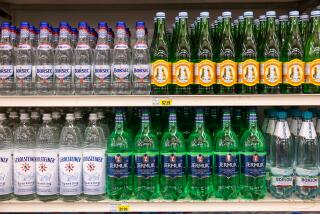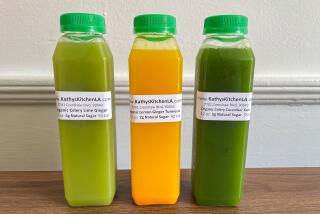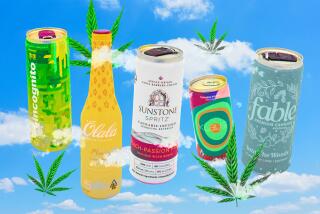Energy Drinks Adding Some Fizz to Niche Player’s Sales
- Share via
Hansen Natural Corp. is a California company, born and raised. Seventy years after Hubert Hansen started selling fresh, unpasteurized juices to Hollywood studios, about 60% of the company’s revenue still comes from sales in the Golden State.
That hefty percentage sums up the Corona-based company’s problems and its potential.
Hansen has earned its reputation as a premium beverage company by correctly identifying what will appeal to the taste buds of trend-setting Californians. But the company hasn’t kept pace with its hard-charging competitors.
Norwalk, Conn.-based SoBe Beverages Inc., which opened for business in 1997, hopes to sell 25 million cases this year of drinks such as Lizard Fuel and Liz Blizz. In contrast, Hansen sold just 6.9 million cases in 1999.
Measured another way, Snapple’s advertising and marketing budget in 1999 was twice Hansen’s record 1999 revenue of $72.3 million.
“Hansen always has been able to follow the path through the woods to find the new and the novel,” said Tom Pirko, a Santa Barbara-based beverage industry consultant who thought enough of the company to try to buy it a decade ago. “They’ve known that it doesn’t pay to stand in there and bash your head against Coke and Pepsi. It’s an interesting story. But it’s a small story that, you have to think, could have been a bigger story.”
Hansen Chief Executive Rodney Sacks acknowledges there are faster ways to grow, but he says that the company is expanding at a healthy and sustainable rate.
“It’s all a question of timing,” Sacks said. “How do you choose to do it? You have to walk before you run. A large [company] with deep pockets could maybe take one or two niche brands that have built up real credibility and take them mainstream more quickly. But, by doing those things, you have to pay [grocery store] slotting fees and do all those other things. We’ll grow it slowly by doing it internally.”
But Hansen isn’t sitting on the sidelines. During the early 1990s, most of its revenue was driven by sales of its line of natural sodas with such names as Mandarin Lime and Kiwi Strawberry that were sold by Trader Joe’s, Costco and other retailers.
In 1996, the company correctly identified the burgeoning market for what the industry calls energy or healthy drinks. The drinks are fortified with a wide range of ingredients--including vitamins, minerals and caffeine. Sacks calls them “functional beverages that deliver a benefit to the consumer in addition to simply delivering refreshment.”
Nearly 75% of Hansen’s revenue now is driven by drinks with names such as Anti-Ox, Stamina, Energy and Power. The drinks have fresh, natural flavors and include a healthy dollop of vitamins. They also feature such ingredients as taurine, ginseng and ginkgo, which, proponents say, provide energy.
Some nutritionists say that proper diet negates the need for vitamin-enriched drinks. Consumers who read the fine print on the Energy drink line find cautionary labeling that the beverage “is not intended to diagnose, treat, cure or prevent any disease.” Another line cautions that Energy is “not recommended for children or persons sensitive to caffeine.”
Despite the caveats, products such as Hansen Energy are helping drive the fast-growing “New Age” beverage segment that includes everything from premium sodas and sparkling water to sports drinks, smoothies and the functional beverages.
The market segment has grown to $8.6 billion, according to New York-based Beverage Marketing Corp., which tracks beverage sales.
“Other than water, energy drinks are probably the hottest segment right now,” said Gary Hemphill, senior vice president of Beverage Marketing Corp. “SoBe has probably been the most successful, but Hansen has also had success, along with Snapple, which has begun adding beneficial ingredients to some of its beverages. It’s a concept that consumers seem to be embracing.”
Eventually, the New Age market will grow large enough to entice industry leaders Coca-Cola Co. and Pepsi-Cola Co. Those giants “really need a category to be pretty substantial before they’ll jump in,” Hemphill said. “Look at sports drinks, where Gatorade got to a certain size before Pepsi came in with All Sport and Coke came with Powerade.”
The functional or energy sector will continue to evolve at a fast pace because consumers are fickle. Pirko says Hansen’s heritage suggests that it will continue to be a player: “Hansen has been good at taking advantages of waves just before they break, and in this category, that’s a good place to be.”
Hansen avoids paying expensive slotting fees needed to secure shelf space in major chains and doesn’t spend heavily on advertising and marketing. Instead, the company feeds demand for its functional beverages by using distributors to stock drink coolers at gas stations and convenience stores.
That sounds hit and miss, but beverage industry observers say it’s a logical way to reach thirsty--and free-spending--guys.
The company recently signed the Chicago Cubs’ Sammy Sosa to pitch the company’s Energy drink line. The deal marks a coup of sorts for the small company because Sosa--whose contract with Pepsi-Cola doesn’t include functional beverages--asked to do the deal.
“I wanted to represent Hansen’s Energy because I believe in this product,” said Sosa, who demanded that Hansen keep him supplied with Hansen Energy at home and on the road. “I’m going to do everything I can to take this company to the top.”
Sacks also hopes to spur growth by leveraging the beverage company’s name through the addition of energy bars and a fortified breakfast cereal. The company makes drinks that target everyone from kids to senior citizens.
It also is selling a super-premium version of its venerable sodas, which, like many of the new lines, offers the promise of heftier profit margins.
But don’t expect the new product lines to prompt a dramatic departure from the deliberate growth strategy that has sheltered Hansen from the roller-coaster ride that characterizes Snapple in recent years.
Snapple was born in Brooklyn about the same time Hansen’s began selling its sodas--in the early 1970s. That’s where the similarities end.
Quaker Oats paid a staggering $1.7 billion for Snapple in 1994, only to see sales sink to 44 million cases from 70 million when the food company failed in its bid to turn Snapple into a broad-based brand. Snapple was acquired by Triarc Cos. in 1997 for $300 million. Triarc is now readying an initial public stock offering for its Snapple unit.
“We know we need to be able to create growth opportunities in what’s a very competitive category,” Sacks said. “Right now that means marketing a very good functional beverage.”
(BEGIN TEXT OF INFOBOX / INFOGRAPHIC)
Healthy Growth
Hansen Natural Corp. began trading Nov. 8, 1990, and is quoted on the Nasdaq Small-Cap Market under the symbol HANS. The Corona-based company has about 900 shareholders.Case sales have risen steadily ... and so has revenue.
1999:
6.9 million cases
1999:
$72.3 million
Source: Hansen Natural Corp.
And the “New Age” beverage segment has grown to $8.6 billion from $5.2 billion in 1994.
1999 wholesale dollar sales of “New Age” beverages, in billions:
Source: Beverage Marketing Corp.
More to Read
Inside the business of entertainment
The Wide Shot brings you news, analysis and insights on everything from streaming wars to production — and what it all means for the future.
You may occasionally receive promotional content from the Los Angeles Times.










